We tested 22 products from 15 companies, dividing the playing field into four categories based on the type of stain remover: gel, liquid, spray, and powder. Those tested included products from Boatlife, Davis FSR, Interlux, Marykate, Spray Nine, West Marine, Y-10, Aurora, Nautical Ease, Star brite, Poli-Ox, Boat Brite, MDR Amazon, Sudbury, and Toon Brite. Picking the top products was a tough job considering the minor differences in performance. We found that the thicker gels worked best and were the safest to use. They are easier to apply thanks to their easy-to-see color and their consistency. In the end, all of the Excellent rated products are effective, but to avoid the cleaners with sinus-scorching vapors, go by the individual product descriptions in the review.
****
We’ve all seen it. That slow buildup of brown discoloration along a boat’s waterline, sometimes growing with time to a darker brown or gray with layers of dirt, speckled black dots, a fuzzy growth, and even an embedded greasy scum. More noticeable on otherwise nice white fiberglass hulls, that boat-long streak known along the Intracoastal Waterway as the “ICW mustache” survives normal washdowns.
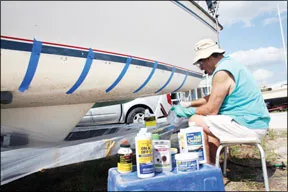
Causes vary, depending on the waters where the vessel spends most of its time. The tea-colored stain may be from natural tannin in freshwater lakes, rivers, and brackish estuaries. Tannic acids from oak bark and leaves have been used for centuries to cure leather, leaving that distinctive brown color. Add some algae growth, some metallic salts, and a little oil and pollution, and the stain from the chemical reaction on the fiberglass or paint can seem permanent.
Attacking these waterline stains should be done with care and forethought. An aggressive use of gritty cleaners like Ajax and Comet will remove some of the dirt but could damage the gelcoat. The shiny outer layer of gelcoat can be quite thin and vulnerable to rubbing with abrasive cleaners. Depending on age, UV exposure, and wax, the gelcoat will oxidize and become more porous, thus more susceptible to deeper staining. Needless to say, a well-kept, waxed hull is easier to clean than one left to the elements.
WHAT WE TESTED
Bearing in mind that there are numerous hull cleaners available, we focused on products marketed as capable of eliminating waterline stains. We tested 22 products from 15 different companies, dividing the playing field into four categories based on the type of stain remover: gel, liquid, spray, and powder.
Going by the list of the test products active ingredients, it’s apparent that the marine industry believes some form of acid should be used to remove waterline stains. The more-effective products depend on the chemical reaction of one or several of the following acids. Oxalic and phosphoric acids dissolve metal ions, such as rust and metallic salts, and some organic substances. Sulfuric acid is also a strong mineral acid and will attack many organic compounds. Hydrochloric acid is a very strong acid that can quickly dissolve most anything organic, is very caustic, and has a strong-smelling vapor. Hydrogen chloride becomes hydrochloric acid when mixed with water. All of these can be very dangerous in high concentrations, are highly corrosive, and can burn skin.
HOW WE TESTED
The test platform was a hauled-out Precision 21 that sails on the saltwater Intracoastal Waterway in Sarasota, Fla. The Precisions white fiberglass had no bottom paint and sported a definitive light-brown waterline discoloration with a darker brown scum stripe and a few small barnacles.
The bottom of the boat from the waterline stripe down was divided into 1-foot-wide sections with bright blue 2-inch masking tape. Each section was marked and numbered 1 through 22, and each product was assigned a number to correspond.
For comparison, we left a section untouched and used some standard household cleaners on other sections. The standard cleaners did remove some of the scum and crud but did not remove the brown stains.
Each test product was applied following the manufacturer’s instructions, and testers noted their smell, cleaning speed, and cleaning performance.
GELS
Boatlife Fiberglass Kreme Cleaner & Stain Remover is a semi-liquid gel solution of phosphoric acid. Applying it with a roller and letting it sit for a few minutes before rinsing did remove the algae and rust stains, but not all of the brown background stain.
Davis FSR Fiberglass Stain Remover is a small jar of blue, stain-absorbing, oxalic acid gel. The gel is thick enough to adhere to the hull curves without running. After a minute and a light brushing with the foam brush, all of the stains on the test boat were gone. It was fast and easy.
Interlux Heavy Duty Stain Removers bottle has a small spout that makes pouring the gel easy. It says “Paint Safe” on the bottle, whereas other acid-based cleaners say to be careful using them on paint. The gel formula is a balance of cleaning chemicals, including oxalic acid, that was easy to apply, worked fast, and whitened the hull nicely.
Marykate On & Off Gel Fiberglass Hull & Bottom Cleaner consists mostly of hydrogen chloride and phosphoric acid. In large letters it says “Fresh Scent,” but goes on to warn “…corrosive…vapor harmful…don’t inhale…” The odor was strong, but the results were fast and excellent.
Spray Nine Boat Bottom Cleaner contains multiple acids, including oxalic, phosphoric, and nonoxynol. It was fast with excellent results.
West Marine Fiberglass Stain Remover includes oxalic acid. It was easy to apply (with a sponge), and after two minutes, it rinsed off with effective results.
Y-10 Original Fiberglass Stain Remover is a thick blue, oxalic acid gel that brushes on easily with a sponge applicator. Testers let it sit for about two minutes. After rinsing, the hull was bright and white.
Bottom Line:
Testers found the gels to be the most effective of the four types of hull cleaners. All produced good results, but the Marykate, Spray Nine, Davis, Interlux, and Y-10 outperformed the others.
LIQUIDS

Aurora Waterline Stain Remover is a strong hydrochloric acid solution. Using a foam brush and very little brushing, testers found, it instantly removed the brown stain and most of the black line.
Marykate On & Off Hull & Bottom Cleaner has the same acid ingredients as the Marykate gel. It appears to be quite concentrated: It has a strong irritating vapor; it dissolved the applicator sponge; and the wind blown spray from rinsing could be felt as pin-sized burns on the skin. However, the stuff works fast and all stains were removed.
Nautical Ease Boat Bottom Cleaner is a concentrated, liquid hydrochloric acid with an obvious, strong acid smell. It immediately removed all stains but destroyed the applicator sponge in seconds. The small sponge shriveled and fell off the metal applicator handle, turned into a small foaming mushroom on the ground, and dissolved into the dirt. But the boat was shiny white. In Nautical Eases defense, the company does recommend using a paint roller for application, but that won’t lessen the harshness of the chemical cleaner.
Star brite Instant Hull Cleaner is the companys strong liquid oxalic acid formulated to remove algae, fish blood, and scum lines. It was fast and effective on our test boat.
Star brite Ez-On Ez-Off Hull & Bottom Cleaner is a liquid hydrochloric acid-based cleaner said to be effective for removing marine deposits. It has a strong acid smell, but did an excellent job of removing the waterline stains.
Star brite Sea Safe Hull Cleaner is an oxalic acid-based cleaner marketed as a safe, biodegradable environmentally correct way to remove hull stains. It was just as fast and effective as the other Star brite cleaners without the harsh fumes of some of the others.
West Marine Hull Cleaner is a fairly strong oxalic acid. The concentrated formula “…can cause damage to bottom paint,” so be careful where you use it. It took the stains off immediately.
West Marine Ez-On Ez-Off Extra Strength Hull & Bottom Cleaner is an “inhibited and enhanced” hydrochloric acid. It comes with a bright red “Caution” tag and warnings that its “corrosive vapor is harmful.” Testers applied the liquid with a foam brush, and the results were very fast. It removed the stains and the barnacles. Good stuff, but be careful.
Bottom Line: While several liquids performed well, many include harsh, potentially dangerous chemicals. The Star brite Sea Safe and Star brite Ez-On Ez-Off get the nod. The West Marine Ez-On Ez-Off performed well but is harsh and more costly than the others.
POWDERS
Boatlife Fiberglass Powder Cleaner & Stain Remover calls for applying the powder to a wet surface and waiting 15 minutes. We applied a paste of wet powder and lightly scrubbed with a sponge with good results. Most all the brown was gone.
Marykate Crystal Lakes Hull & Bottom Cleaner is an oxalic acid powder. As with the Boatlife powder, you can easily make a diluted solution for different jobs. We chose to apply it as a wet paste, and it did a fine job of brightening the hull.
Poli-Ox Marine Cleanser Oxidation & Rust Remover includes oxalic acid and other compounds and claims to clean dull gelcoat, brown water stains, rust, fish blood, metals, and even teak. We applied the wet paste with a sponge. Minor rubbing for about a minute had excellent results.
Bottom Line: The Poli-Ox out-performed the others, can be used on a variety of surfaces, and is the cheapest powder.
SPRAYS
Boat Brite Algae and Waterline Stain Remover comes with a detachable sprayer and claims to have safe, non-toxic, and non-harsh chemicals. It was one of a few that did not list an acid as an active ingredient. It sprayed on easily, and with just a little rubbing, it did a good job of removing the brown stains.
MDR Waterline Stain Remover comes as a spray bottle. Although the ingredients are not mentioned, it sprayed on easily, results were excellent and fast, and a little scrubbing with the sponge also removed some barnacles.
Sudbury Hull Cleaner & Stain Remover comes in a convenient spray bottle with a hydrochloric acid solution. The instructions say to “spray on and scrub vigorously…,” which overall did a good job. It removed some barnacles but left a slight hint of the brown line.
Toon Brite Fiberglass Boat/RV Cleaner comes with a detachable sprayer and contains a blended mixture of acids, including sulfuric and phosphoric acids. The instructions call for diluting it with water, which we did at 50/50. That mixture cleaned pretty well, but a later attempt with a full-strength mix did a much better job, removing all the brown discoloration.
Bottom Line: The MDR Waterline Stain Remover and the Toon Brite were the standouts among sprays. However, the Toon Brite must be used at full strength and be scrubbed, so the top pick goes to MDR.
Conclusions
There were no clear winners. All 22 test products did a good to excellent job of quickly removing the waterline stains on our test sailboat.
Picking the top products was a tough job considering the minor differences in performance. So to narrow the field, testers focused equally on performance, application, chemical harshness, and pricing.
We found that the thicker gels worked best and were the safest to use. They are easier to apply thanks to their easy-to-see color and their consistency. The Spray Nine was as effective as the other top gels, was fast, and also was the cheapest.
The powders were testers second favorite type because the liquid paste did not run and could be easily sponged onto the gelcoat. Poli-Ox was the top powder.
Our third choice for waterline removers would be the sprays. They allow faster application to a whole boat, but should be used with care. MDR was testers favorite, holding a slight edge over the Toon Brite.
The liquids, which must be handled with more care, were testers least favorite type. The Star brite Ez-On Ez-Off was effective, and less harsh than some of the others. It also carries a better price.
The overall Best Choice and Budget Buy is the Spray Nine. Its an easy-to-use gel with less-harsh properties, an excellent cleaning ability, and a great price.
In the end, all of the “Excellent” rated products are effective, but to avoid the cleaners with sinus-scorching vapors, go by the individual product descriptions.










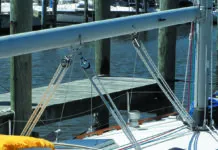

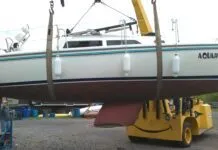


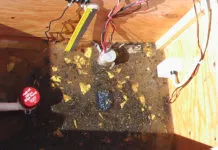


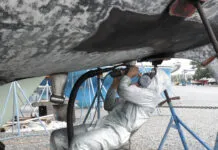












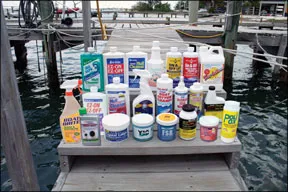





I like Star Brite Ez-On Ez-Off cleaner, I think this is one of the best fiberglass cleaner available commercially. It effectively loosens marine deposits and stains for easy cleaning, the fast-acting formula removes dirt fast.
MaryKate On-Off also a good cleaner. The stuff works fast and versatile in cleaning surfaces on the boat’s fiberglass hulls and bottoms.
It is no joke to own a boat. The insurance, docking fees, and registration are quite expensive, too. Not to mention, it needs regular maintenance to keep it looking new and in good condition.
In my experience, I find it easier and faster to deal with the stains with a non-stick and gentle deck cleaner before finally applying some finishing scrubbing to polish the surface.
Your boat will look dirty and eventually lose its value if you don’t maintain it properly. It’s why you need to learn how to clean fiberglass boat deck, especially if you’re using your boat more often, or it stays 24/7 in the water.
I have found that On & Off doesn’t need to be used full strength to be effective. 1 part to 10 parts water works just fine and applied with a brush. Roller or sponge application probably good as well, maybe better, but haven’t tried. Brush on and sit for a few minutes then hose off. Much more economic, and environmental, use.
Agreed On/off is a solid performer because of it’s corrosive chemicals – phosphoric acid. You must apply wax after use or you’ll end up with a permanent mustache on the boat. The acids eat the wax right off.
Would be nice if there was a product that cleaned and didn’t kill your wax job.
Where did you buy the Spray Nine Boat bottom Cleaner? I can’t find any sources in the USA; not even Amazon! Found a Canadian supplier but they only ship to Canada. Went to the Spray Nine website and it wasn’t even listed there …
Soft scrub works great. and very reasonably priced.
Spray Nine, which one is it, blue or green?